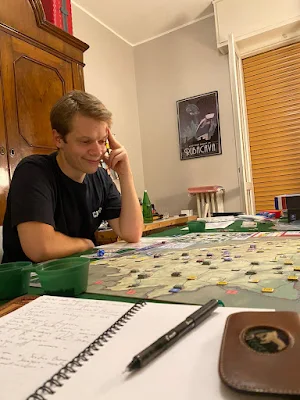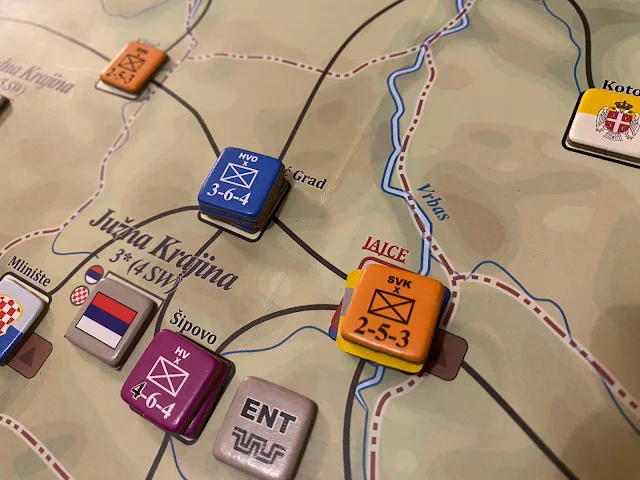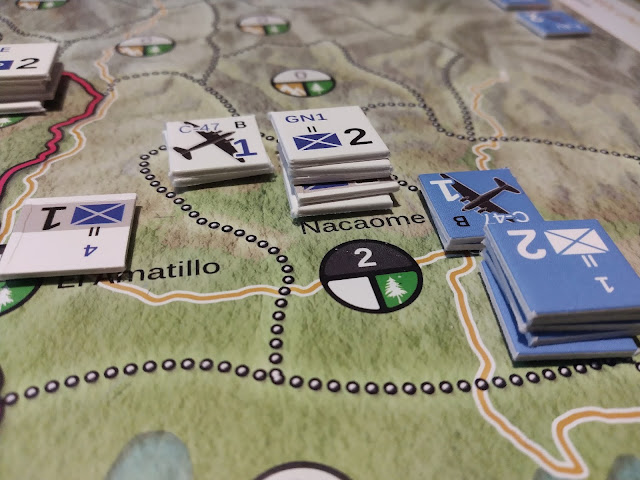Brotherhood & Unity. The Sarajevo pocket
Serbian: Laura Beltrami
Croatian: Marcello Vezzosi
Bosniak: Alex Isabelle
It is the early 1990s and Bosnia and Herzegovina finds themselves to be the sad theater of growing ethnic tensions. Similarly to many territories in central-eastern Europe, in fact, this area of the Balkans hosts a multitude of nationalities who see themselves first of all as Serbs, Croats and Muslims, and only secondarily as Bosniaks. The perfect recipe for a disaster, which brew throughout all of the twentieth century: the region, initially a periphery of the Ottoman Empire, was incorporated by the Austro-Hungarian Empire following the Russo-Turkish War. Soon came the time of the Trianon Treaty, which split the Empire into several small states, laying the foundations for a resentment that would be shared by the entire Balkan area and that would not fade with the birth of the Kingdom of Yugoslavia. After a Second World War strongly fueled ALSO by these tensions, the Tito dictatorship was able to keep the situation standing, to the advantage of Bosnia-Herzegovina which, due to its central position in the country, was chosen as the seat of military defence. In addition to filling it with weapons, this led it to experience a rather rapid development, which stopped suddenly with the death of Tito. The transition to democracy in this region was characterized by the harsh opposition of three nationalistic parties, respectively representatives of Serbs, Croats and Muslims, who proved incapable of collaborating. The attempt by Serbs and Croats to divide Bosnia-Herzegovina into nationally homogeneous regions to be aggregated to their respective newborn states collided with the evidence that there were no nationally homogeneous areas around there in the first place. A real civil war therefore arose, which saw the various nations opposed, supported by foreign forces, in the case of Serbia and Croatia, and by a few thousand mujāhidīn from the entire Islamic world, in the case of the Bosniaks.
Our scenario opens in 1992, with Sarajevo already closed in a siege against the Bosniaks, who still manage to maintain control of many key districts within the city. The Serbian forces, which have surrounded the city, are being held up by a fragile supply chain starting in Yugoslavia (present-day Serbia had yet to change its name) and extending through the towns of Sokolac, Vlasenica and Zvornik.
 |
| War has just started and the UN already threaten sanctions. |
The Serbs play smart, trying to consider the matter already closed: contacts are made with foreign diplomats, so as to reassure them about the impressive entry into the conflict of military forces from across the border. It is clear that these soldiers are not there to pay a visit, but somehow the Western diplomats allow themselves to be fooled, and the threat of sanctions on Serbia is quickly raised. While this was happening, the Croats launch a coup against the Muslim populations, occupying without finding resistance two important towns in Sredna Bosna, a region of great interest to them. The few Bosniak troops present there escape and regroup further east. The international powers realize that a catastrophe is about to occur and therefore two humanitarian corridors are immediately opened by the UN: one in Srebrenica and the other in Bihać. This immediately puts a stop to the Serbian intentions to attack these important residential centres, which are well defended by Muslim troops anyway, because attacking one of these humanitarian corridors would mean to bring down their international credibility, causing the intervention of American tactical bombers.
The Serbs therefore focus on the (many) other territories which they still need to close the game. They play the first of several "major offensives" by delivering four full-power attacks in various regions of the map. Some of these attacks are launched against the Bosniak, and because of bad luck we discover that several important news networks have their correspondents in those cities. The "Balkan powder keg" therefore ends up in the front pages of half the planet and Serbia sees its international image plummet. Sanctions immediately rain down, followed immediately by the order to go easy on fuel consumption. Even though many of the objectives attacked by this great offensive are liberated, therefore, the troops struggle to immediately control over them.
 |
| Bosniaks barricade themselves in Novi Grad and Novo Sarajevo. |
The Croatian Republic of Bosnia and Herzegovina and the Bosniaks agree that the Serbs have already pissed them off and therefore precautions should be taken. A fragile alliance is opted for which is however underlined by important military preparations on the Croatian side: the Croatian defense ministry, Gojko Šušak, invests foreign money in a project to strengthen the HVO, the "Croatian Defense Council", namely the Bosnian Croat army, which receives ammunition, weapons and logistical support. For the next two years this will give the HVO a clear advantage against the Bosniaks, who will all the more put aside any intentions of facing the Croatians in an open field. The Muslims agree to leave the control of the important region of Sredna Bosna to the Croats, and withdraw in an orderly fashion from Zenica, distributing their troops in areas threatened by the Serbs. At the same time, defenses are set up in Novi Grad and Novo Sarajevo, two of the key points to control the city.
The Serbs first of all interrupt the attacks, making contact with American diplomats so as to cut off the flow of international sanctions to Serbia. Then as soon as things go as they want they bombard Sarajevo with artillery, killing many of the unprepared Bosniaks. This finally kicks off the battle for control of the capital: the Bosniaks, strengthened by the presence of Arab foreign fighters in the Podrinje region, attack the village of Sokolac, one of the nodes that keeps the Serbian supply chain standing in Sarajevo. On paper, the attack is all to the advantage of the Muslims, but their very little war preparation, combined with the fact that on the other side there is the war hero Slavko Lisica in command of the troops, means that, however weakened, the Serbian troops manage to keep control of the town. Immediately afterwards the Serbs attack the bombed Novo Sarajevo from the north, carrying out a massacre and taking control of it.
 |
| Bosniak troops, guided by mujāhidīn, attack the sparse defences of Sokolac. |
1992 therefore ends badly for the Bosniak forces, who however do not give up. At the dawn of 1993 they immediately attack Sokolac again, and this time they manage to fend off the Serbs. Suddenly the supply chain for Serbian troops in Sarajevo collapses, half of whom begin to have doubts about the success of the mission. Strengthened by the fact that Bosniaks and Serbs seem to be uninterested in them, the Croats in the meanwhile send in heavy vehicles from across the border, reinforcing some units, and then attack Istočni Mostar, controlled by the Serbs. If the conflict, so far, has primarily seen regular troops engaged against Bosniak paramilitary units, now there is an open confrontation between two regular armies subsidized by foreign powers. At the end of this first big battle both Serbs and Croats receive the same number of casualties, and the east side of the city of Mostar does not change its control.
 |
| Croatia observes critically the Serbian maneuvers in Posavina. |
The Serbs would like to counterattack but they have to resolve the issue of the pocket of Sarajevo: with a discreet group of forces they attack the mountain town of Vareš, which if conquered would allow them to reopen the lines of communication with Sarajevo, but the Bosniaks offer tenacious resistance and do not give in. Half of the Serbian troops in Sarajevo are, at this point, completely out of supply. For the rest of the year, the clashes in Mostar will continue, with neither the Croatians nor the Serbs being able to get the upper hand. Similarly, despite reinforcements from Tuzla, the Serbs insist and in any case are unable to break through the pocket of Sarajevo. Finally, at the end of 1993, the thousands of soldiers whose war effort cannot be supported by the occupied districts of Sarajevo alone desert, effectively leaving the capital without half of the soldiers initially engaged in besieging it.
Despite this, the year ends with a Serbian offensive in northern Bosnia, aimed at opening the "Posavina corridor": all of the regions to the north-west, largely occupied by Serbia, since the beginning of the war have been in fact subject to a regime of limited supplies, because there is no direct link between them and Yugoslavia. The Posavina region, if conquered, would make it possible to create that logistic bridge, allowing those regions to be fully fed and to organize a new advance from the north. The offensive towards Posavina fails to establish full control over the entire region, which remains disputed between all three forces involved, but manages to wrest the city of Gradačac from Muslim control. Thanks to this rapid advance, the bridge between the western territories and Yugoslavia is, at least, open, which mitigates the severity of the scenario in the capital.
.jpeg) |
| The troops retreating from Zenica descend from the North, while Serbs barricade themselves around Novo Sarajevo. |
When 1994 arrives, two years have passed since the beginning of the war, and the Bosniaks have finally managed to organize themselves. The strategic benefits of the Croatians decay, and the Muslims now have the initiative (and more powerful cards), while the impact strength of the Serbs is greatly reduced by less apocalyptic cards and by an unhappy turn sequence, as well as by very small reinforcements. The Serbian leadership decides to mitigate the problem by bringing in paramilitary groups from across the border, at the cost of worsening their diplomatic relations a little: the SDK, the Serbian Volunteer Guard, a paramilitary group better known as "Arkan's Tigers", therefore appears. In real history these distinguished themselves with numerous war crimes. This comes just a few days before the Vance-Owen plan for an end to hostilities is proposed, a plan which, under threat of further sanctions, is accepted by Serbia, but not by the Serbs of Bosnia-Herzegovina, who don't give a shit about the cease-fire and keep fighting. As a result, the Serbian presidency goes nuts and imposes an embargo on the latter, withdrawing the Arkan's Tigers from the field, which will never be seen again. Enraged, the Serbs target several Bosniak and Croatian bases with artillery fire, but this fails to slow down the collapse of their front: the Croatian attacks Brčko, a city on the border with Yugoslavia which, if taken, would once again close the Posavina corridor. After days of intense fighting, the Serbian manages to keep control of the city, also thanks to a remnant of air superiority. Soon after however the Croatian attacks Istočni Mostar again, and this time there is nothing that holds: the Croatian passes the well-known World Heritage bridge (which DOES NOT collapse!) and puts his flag on Western Herzegovina, which brings him definitely closer to its territorial objectives. Immediately afterwards, it is time for the Bosniak advance on Sarajevo: the troops that had withdrawn from Zenica the year before proceeded southwards, occupying the peripheral district of Semizovac and then the important suburb of Vogošća, one of the key points which still supported the Serbian forces in the city. Soon after the forces stationed in the neighborhoods of Novi Grad and in the city center of Sarajevo attack the troops stationed in Novo Sarajevo, carrying out a massacre there but failing to gain control due to international sanctions which, at this point, also affect the Bosniaks, forcing them to slow down their advance at its key moment. The few die-hard Serbs left in the city gather in a now completely demolished Novo Sarajevo, gearing up to defend themselves against forthcoming advances.
.jpeg) |
| Sredna Bosna is totally in Croat hands. |
In the following months the war reaches a stalemate: while the Serbian reorganizes Novo Sarajevo the Croatian mobilizes his troops around the Sredna Bosna, preparing future offensives, and the Bosniak contacts the United Nations to reduce the sanctions. Somehow they succeed. However, a unit of Bosniaks sees in this stillness a form of submission to those international forces which have devastated the country with their interference; as a result, it betrays its own faction by switching to the side of the Bosnian Croats and leading a surprise attack on Visoko, which passes into Croatian hands. The stunned Bosniak troops stationed there retreat towards Sarajevo, which must be conquered at all costs and without interference.
 |
| Bosniak traitors, now a regular Croatian unit, occupy Visoko. |
Finally we come to 1995, the last year of the conflict. This opens with the final advance of the Bosniaks on Novo Sarajevo, led by the war criminal Atif Dudaković, who shows up in the city leading mechanized infantry. The Serbian defenses collapse badly, and immediately afterwards the motorized vehicles of the Bosniak army take control of most of the peripheral districts of the city, now abandoned by the Serbs. With the taking of the latter districts, the Bosniaks gain full control over the capital Sarajevo.
The war in the south central area of the map is now over. The conflict returns to the Posavina area, where the Serb increases her activity to try to obtain full control of the region, however clashing with a Croatian who does not intend to give up his positions. On the contrary: he bombs the city of Jajce, capital of Južná Krajina, to then attempt an attack on the city, which however remains under the control of the SVK, the Army of the Serbian Republic of Krajina, a military corps of dubious legitimacy which was historically swept away from the Croatian advance in Krajna, and which here instead resists, while maintaining control of the rest of the region. The Bosniak proposes to Serbia to move the troops from Vlasenica to the north, boasting of wanting to coordinate a combined attack in Sredna Bosna so as to stop a Croatian advance which is starting to get problematic: the Serbian senses that there is an bullshit around the corner and rightly does not move her troops. The Muslims, confirming the Serb doubts, then attack with all their strength various inhabited centers in the north-east, starting from Vlasenica, attempting a lightning-fast conquest of Semberija, a region essentially of no interest to Bosnian Muslims, but which if conquered it would still give them greater credibility in the now imminent peace negotiations. Despite the surprise and the impressive means available to the Muslims, i.e. thousands of mujāhidīn, fortunately the Serbs manage to keep control of the region, only losing the city of Vlasenica, which beyond its strategic importance is not an important center of power. This turn of events disengages an escalation in Bosnia and Herzegovina's ethnic conflict, which would likely have resulted in ethnic cleansing and other crimes against humanity.
.jpeg) |
| The final Bosniak advance in Semberija fails. |
The game then ends with a general stalemate and a race for diplomacy. The United Nations finally achieve a ceasefire from all warring parties. The Bosniak control of the city of Sarajevo proves to be an important fact at the time of the negotiations, as well as the homogeneous control of the regions primarily inhabited by Muslims, including the Cazinska Krajina, untouched by the conflict also thanks to the humanitarian corridor established in Bihać by the the UN, and with the sole exception of Sredna Bosna, completely controlled by the Croatian, on which, however, the failed conquest of Južná Krajina and Posavina weighs. The Serbian, however, has left too many key territories in the hands of her opponents. At the end of the peace accords, therefore, the Bosniak line prevails, that is to say that Bosnia-Herzegovina continues to exist with the initial borders, and it returns to a status-quo which attempts to make the coexistence, albeit with painful difficulties, of the various nationalities that populate it.
The future of Bosnia-Herzegovina promises to be complicated. Peoples who have shot each other for four years will have to learn to coexist. Will the country ever be able to reach the glories it knew at the time of Tito's dictatorship? Maybe. That's another story.
Do you want to read other stories? Click here for the full list.
 |
| Serbia is not happy about how things turned out. |
 |
| The Army of the Serbian Republic of Krajina resists the impact with the Croatians and does not give up Jajce, maintaining a tenuous control over the region. |
.jpeg) |
| Semberija at the end of the war. |
.jpeg)



Comments
Post a Comment